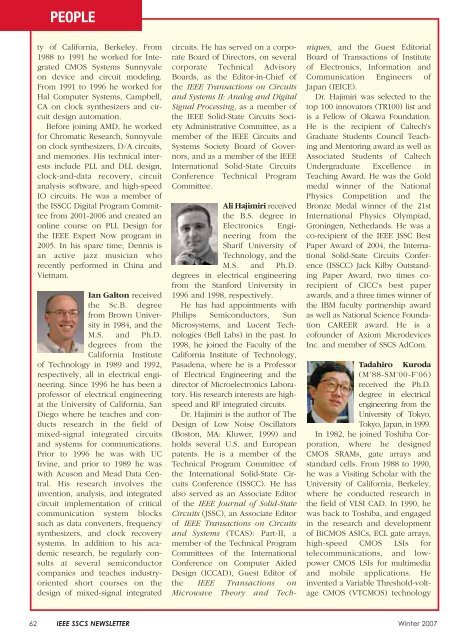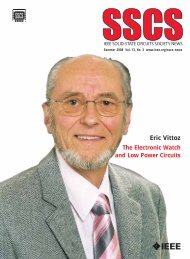The Impact of Dennard's Scaling Theory - IEEE
The Impact of Dennard's Scaling Theory - IEEE
The Impact of Dennard's Scaling Theory - IEEE
- TAGS
- scaling
- www.ieee.org
You also want an ePaper? Increase the reach of your titles
YUMPU automatically turns print PDFs into web optimized ePapers that Google loves.
PEOPLE<br />
ty <strong>of</strong> California, Berkeley. From<br />
1988 to 1991 he worked for Integrated<br />
CMOS Systems Sunnyvale<br />
on device and circuit modeling.<br />
From 1991 to 1996 he worked for<br />
Hal Computer Systems, Campbell,<br />
CA on clock synthesizers and circuit<br />
design automation.<br />
Before joining AMD, he worked<br />
for Chromatic Research, Sunnyvale<br />
on clock synthesizers, D/A circuits,<br />
and memories. His technical interests<br />
include PLL and DLL design,<br />
clock-and-data recovery, circuit<br />
analysis s<strong>of</strong>tware, and high-speed<br />
IO circuits. He was a member <strong>of</strong><br />
the ISSCC Digital Program Committee<br />
from 2001-2006 and created an<br />
online course on PLL Design for<br />
the <strong>IEEE</strong> Expert Now program in<br />
2005. In his spare time, Dennis is<br />
an active jazz musician who<br />
recently performed in China and<br />
Vietnam.<br />
Ian Galton received<br />
the Sc.B. degree<br />
from Brown University<br />
in 1984, and the<br />
M.S. and Ph.D.<br />
degrees from the<br />
California Institute<br />
<strong>of</strong> Technology in 1989 and 1992,<br />
respectively, all in electrical engineering.<br />
Since 1996 he has been a<br />
pr<strong>of</strong>essor <strong>of</strong> electrical engineering<br />
at the University <strong>of</strong> California, San<br />
Diego where he teaches and conducts<br />
research in the field <strong>of</strong><br />
mixed-signal integrated circuits<br />
and systems for communications.<br />
Prior to 1996 he was with UC<br />
Irvine, and prior to 1989 he was<br />
with Acuson and Mead Data Central.<br />
His research involves the<br />
invention, analysis, and integrated<br />
circuit implementation <strong>of</strong> critical<br />
communication system blocks<br />
such as data converters, frequency<br />
synthesizers, and clock recovery<br />
systems. In addition to his academic<br />
research, he regularly consults<br />
at several semiconductor<br />
companies and teaches industryoriented<br />
short courses on the<br />
design <strong>of</strong> mixed-signal integrated<br />
circuits. He has served on a corporate<br />
Board <strong>of</strong> Directors, on several<br />
corporate Technical Advisory<br />
Boards, as the Editor-in-Chief <strong>of</strong><br />
the <strong>IEEE</strong> Transactions on Circuits<br />
and Systems II: Analog and Digital<br />
Signal Processing, as a member <strong>of</strong><br />
the <strong>IEEE</strong> Solid-State Circuits Society<br />
Administrative Committee, as a<br />
member <strong>of</strong> the <strong>IEEE</strong> Circuits and<br />
Systems Society Board <strong>of</strong> Governors,<br />
and as a member <strong>of</strong> the <strong>IEEE</strong><br />
International Solid-State Circuits<br />
Conference Technical Program<br />
Committee.<br />
Ali Hajimiri received<br />
the B.S. degree in<br />
Electronics Engineering<br />
from the<br />
Sharif University <strong>of</strong><br />
Technology, and the<br />
M.S. and Ph.D.<br />
degrees in electrical engineering<br />
from the Stanford University in<br />
1996 and 1998, respectively.<br />
He has had appointments with<br />
Philips Semiconductors, Sun<br />
Microsystems, and Lucent Technologies<br />
(Bell Labs) in the past. In<br />
1998, he joined the Faculty <strong>of</strong> the<br />
California Institute <strong>of</strong> Technology,<br />
Pasadena, where he is a Pr<strong>of</strong>essor<br />
<strong>of</strong> Electrical Engineering and the<br />
director <strong>of</strong> Microelectronics Laboratory.<br />
His research interests are highspeed<br />
and RF integrated circuits.<br />
Dr. Hajimiri is the author <strong>of</strong> <strong>The</strong><br />
Design <strong>of</strong> Low Noise Oscillators<br />
(Boston, MA: Kluwer, 1999) and<br />
holds several U.S. and European<br />
patents. He is a member <strong>of</strong> the<br />
Technical Program Committee <strong>of</strong><br />
the International Solid-State Circuits<br />
Conference (ISSCC). He has<br />
also served as an Associate Editor<br />
<strong>of</strong> the <strong>IEEE</strong> Journal <strong>of</strong> Solid-State<br />
Circuits (JSSC), an Associate Editor<br />
<strong>of</strong> <strong>IEEE</strong> Transactions on Circuits<br />
and Systems (TCAS): Part-II, a<br />
member <strong>of</strong> the Technical Program<br />
Committees <strong>of</strong> the International<br />
Conference on Computer Aided<br />
Design (ICCAD), Guest Editor <strong>of</strong><br />
the <strong>IEEE</strong> Transactions on<br />
Microwave <strong>The</strong>ory and Tech-<br />
niques, and the Guest Editorial<br />
Board <strong>of</strong> Transactions <strong>of</strong> Institute<br />
<strong>of</strong> Electronics, Information and<br />
Communication Engineers <strong>of</strong><br />
Japan (IEICE).<br />
Dr. Hajimiri was selected to the<br />
top 100 innovators (TR100) list and<br />
is a Fellow <strong>of</strong> Okawa Foundation.<br />
He is the recipient <strong>of</strong> Caltech's<br />
Graduate Students Council Teaching<br />
and Mentoring award as well as<br />
Associated Students <strong>of</strong> Caltech<br />
Undergraduate Excellence in<br />
Teaching Award. He was the Gold<br />
medal winner <strong>of</strong> the National<br />
Physics Competition and the<br />
Bronze Medal winner <strong>of</strong> the 21st<br />
International Physics Olympiad,<br />
Groningen, Netherlands. He was a<br />
co-recipient <strong>of</strong> the <strong>IEEE</strong> JSSC Best<br />
Paper Award <strong>of</strong> 2004, the International<br />
Solid-State Circuits Conference<br />
(ISSCC) Jack Kilby Outstanding<br />
Paper Award, two times corecipient<br />
<strong>of</strong> CICC's best paper<br />
awards, and a three times winner <strong>of</strong><br />
the IBM faculty partnership award<br />
as well as National Science Foundation<br />
CAREER award. He is a<br />
c<strong>of</strong>ounder <strong>of</strong> Axiom Microdevices<br />
Inc. and member <strong>of</strong> SSCS AdCom.<br />
Tadahiro Kuroda<br />
(M’88-SM’00-F’06)<br />
received the Ph.D.<br />
degree in electrical<br />
engineering from the<br />
University <strong>of</strong> Tokyo,<br />
Tokyo, Japan, in 1999.<br />
In 1982, he joined Toshiba Corporation,<br />
where he designed<br />
CMOS SRAMs, gate arrays and<br />
standard cells. From 1988 to 1990,<br />
he was a Visiting Scholar with the<br />
University <strong>of</strong> California, Berkeley,<br />
where he conducted research in<br />
the field <strong>of</strong> VLSI CAD. In 1990, he<br />
was back to Toshiba, and engaged<br />
in the research and development<br />
<strong>of</strong> BiCMOS ASICs, ECL gate arrays,<br />
high-speed CMOS LSIs for<br />
telecommunications, and lowpower<br />
CMOS LSIs for multimedia<br />
and mobile applications. He<br />
invented a Variable Threshold-voltage<br />
CMOS (VTCMOS) technology<br />
62 <strong>IEEE</strong> SSCS NEWSLETTER Winter 2007




